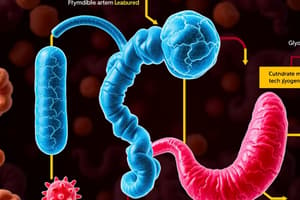Podcast
Questions and Answers
What is the process of synthesizing glycogen from glucose called?
What is the process of synthesizing glycogen from glucose called?
- Glycolysis
- Glucosylation
- Glycogenolysis
- Glycogenesis (correct)
Where in the body is glycogen primarily stored in animals?
Where in the body is glycogen primarily stored in animals?
- Liver and muscles
- Brain and lungs
- Kidneys and intestines
- Heart and pancreas
What role does glycogenolysis play in the liver?
What role does glycogenolysis play in the liver?
- It synthesizes glucose
- It increases muscle energy
- It breaks down lipids
- It adds glucose to the blood (correct)
How is glucose incorporated into glycogen during synthesis?
How is glucose incorporated into glycogen during synthesis?
What type of bonds connect glucose molecules in glycogen?
What type of bonds connect glucose molecules in glycogen?
What type of linkage is formed when glucose transfers to a non-neighboring chain?
What type of linkage is formed when glucose transfers to a non-neighboring chain?
Which enzyme catalyzes the formation of branch points in glycogen synthesis?
Which enzyme catalyzes the formation of branch points in glycogen synthesis?
How does insulin affect glycogen synthesis?
How does insulin affect glycogen synthesis?
Which hormone is responsible for inhibiting glycogen synthesis?
Which hormone is responsible for inhibiting glycogen synthesis?
What is the minimum number of glucose units required to form a 1-6 linkage?
What is the minimum number of glucose units required to form a 1-6 linkage?
What is the process by which pyruvate is converted to acetyl co-enzyme?
What is the process by which pyruvate is converted to acetyl co-enzyme?
What role does the TCA cycle play in metabolism?
What role does the TCA cycle play in metabolism?
What molecule is regenerated at the end of the TCA cycle?
What molecule is regenerated at the end of the TCA cycle?
How many carbon atoms does acetyl co-enzyme contain?
How many carbon atoms does acetyl co-enzyme contain?
What is the primary energy output of the TCA cycle?
What is the primary energy output of the TCA cycle?
What happens to glucokinase when blood glucose concentration is low?
What happens to glucokinase when blood glucose concentration is low?
Which glycolysis reaction is NOT reversible?
Which glycolysis reaction is NOT reversible?
What is the primary function of adding fluoride during blood collection?
What is the primary function of adding fluoride during blood collection?
Where does the TCA cycle primarily take place?
Where does the TCA cycle primarily take place?
What initiates the TCA cycle?
What initiates the TCA cycle?
Flashcards are hidden until you start studying
Study Notes
Metabolism of Glycogen
- Carbohydrates in plants are stored as starch; in animals, they are stored as glycogen primarily in the liver and muscles.
- Glycogenesis is the synthesis of glycogen from glucose.
- Glycogenolysis is the breakdown of glycogen to produce glucose; in the liver, it helps maintain blood glucose levels.
- Muscle tissue primarily uses glucose for energy during contraction.
- Glycogen consists of thousands of alpha glucose molecules and is branched.
- Glucose is converted into uridine diphosphate (UDP) glucose before being incorporated into glycogen.
- Glycogen molecules are linked by α-1,4 glycosidic bonds; enzyme glycogen synthase catalyzes this process.
- A chain of at least 11 glucose units is required for further elongation; a minimum of six glucose units transfers to form α-1,6 linkages due to the branching enzyme.
- Insulin promotes glycogen synthesis, whereas glucagon inhibits it.
Glycolysis
- Glycolysis synthesizes glucose 6-phosphate using ATP in the presence of oxygen.
- Glucokinase is active only at high blood glucose levels, such as after meals.
- Most glycolysis reactions are reversible, with exceptions being hexokinase and phosphofructokinase.
- Fluoride inhibits enolase, which prevents glycolysis in red blood cells during blood glucose collection.
- Insulin serves as a stimulant for glycolysis.
TCA (Tricarboxylic Acid) Cycle
- Also known as the citric acid cycle or Krebs cycle, it is named for the formation of citric acid.
- Citric acid is a tricarboxylic acid containing three carboxyl groups.
- The TCA cycle occurs in the mitochondrial matrix and requires oxygen.
- Red blood cells lack mitochondria, hence they do not engage in the TCA cycle.
Initiation of TCA Cycle
- The TCA cycle is initiated by the reaction of acetyl co-enzyme A, also known as Active Acetate Aerobre.
- Glycolysis products enter the mitochondria and convert to acetyl co-enzyme A through oxidative decarboxylation, involving the loss of CO₂.
- This conversion is facilitated by the pyruvate dehydrogenase complex, showcasing the metabolic flexibility of acetyl co-enzyme A from carbohydrates, proteins, and lipids.
Importance of TCA Cycle
- Serves as the common pathway for final oxidation of carbohydrates, proteins, and fats.
- Functions as an amphibolic pathway, integrating both anabolic and catabolic processes.
- Major contributor to cellular energy production.
- Two carbon atoms from acetyl co-enzyme A are oxidized, releasing CO₂ as a byproduct.
- Oxaloacetate is regenerated at the end of the cyclical pathway, allowing the cycle to continue.
Studying That Suits You
Use AI to generate personalized quizzes and flashcards to suit your learning preferences.



